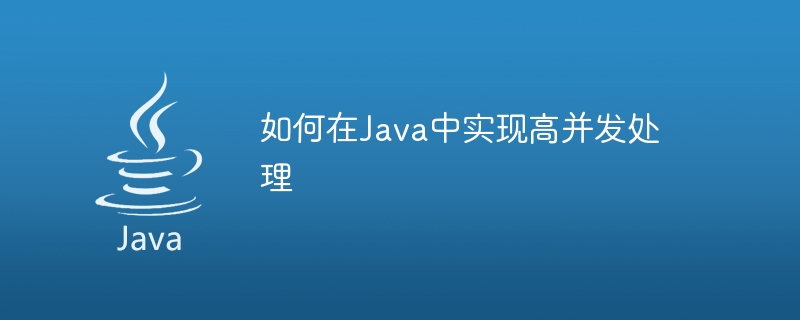如何在Java中实现高并发处理

如何在Java中实现高并发处理,需要具体代码示例
高并发是当今互联网应用开发中的一个重要挑战,尤其是在处理大量并发请求时,如何提高系统的性能和稳定性成为开发者需要解决的关键问题。本文将介绍一些在Java中实现高并发处理的方法,并给出具体的代码示例。
- 使用线程池
线程池是Java中处理并发的一种常见方式,在处理大量并发请求时,可以避免频繁地创建和销毁线程的开销。通过使用线程池,可以重用已经创建的线程,提高系统的响应速度和效率。
下面是一个简单的线程池示例:
import java.util.concurrent.ExecutorService;
import java.util.concurrent.Executors;
public class ThreadPoolExample {
public static void main(String[] args) {
ExecutorService executor = Executors.newFixedThreadPool(10);
for (int i = 0; i < 1000; i++) {
Runnable task = new MyTask();
executor.execute(task);
}
executor.shutdown();
}
}
class MyTask implements Runnable {
@Override
public void run() {
// 在这里编写具体的任务逻辑
System.out.println("Executing task");
}
}- 使用并发集合
Java提供了一些并发集合类,如ConcurrentHashMap和ConcurrentLinkedQueue,可以在多线程环境下安全地进行读写操作。使用并发集合而不是普通的集合类可以避免数据竞争和线程安全问题,提高并发处理的效率和可靠性。
下面是一个使用ConcurrentHashMap的示例:
import java.util.Map;
import java.util.concurrent.ConcurrentHashMap;
public class ConcurrentMapExample {
public static void main(String[] args) {
Map<String, Integer> map = new ConcurrentHashMap<>();
map.put("key1", 1);
map.put("key2", 2);
map.put("key3", 3);
int value = map.get("key1");
System.out.println(value);
}
}- 使用锁机制
在多线程环境下,共享数据的读写操作可能会引发竞争条件,导致数据不一致或者数据错误。使用锁机制可以防止多个线程同时访问共享数据,保证数据的一致性和正确性。
下面是一个简单的使用锁机制的示例:
import java.util.concurrent.locks.Lock;
import java.util.concurrent.locks.ReentrantLock;
public class LockExample {
private static int count = 0;
private static Lock lock = new ReentrantLock();
public static void main(String[] args) {
Runnable task = new MyTask();
Thread thread1 = new Thread(task);
Thread thread2 = new Thread(task);
thread1.start();
thread2.start();
try {
thread1.join();
thread2.join();
} catch (InterruptedException e) {
e.printStackTrace();
}
System.out.println(count);
}
static class MyTask implements Runnable {
@Override
public void run() {
for (int i = 0; i < 10000; i++) {
lock.lock();
try {
count++;
} finally {
lock.unlock();
}
}
}
}
}通过使用线程池、并发集合和锁机制,可以在Java中实现高并发处理。当然,除了以上的方法,还有其他一些优化技巧,如使用非阻塞IO、使用缓存等等,开发者可以根据具体的应用场景选择合适的方法。
以上是如何在Java中实现高并发处理的详细内容。更多信息请关注PHP中文网其他相关文章!

热AI工具

Undresser.AI Undress
人工智能驱动的应用程序,用于创建逼真的裸体照片

AI Clothes Remover
用于从照片中去除衣服的在线人工智能工具。

Undress AI Tool
免费脱衣服图片

Clothoff.io
AI脱衣机

Video Face Swap
使用我们完全免费的人工智能换脸工具轻松在任何视频中换脸!

热门文章

热工具

记事本++7.3.1
好用且免费的代码编辑器

SublimeText3汉化版
中文版,非常好用

禅工作室 13.0.1
功能强大的PHP集成开发环境

Dreamweaver CS6
视觉化网页开发工具

SublimeText3 Mac版
神级代码编辑软件(SublimeText3)
 C++ 函数异常与多线程:并发环境下的错误处理
May 04, 2024 pm 04:42 PM
C++ 函数异常与多线程:并发环境下的错误处理
May 04, 2024 pm 04:42 PM
C++中函数异常处理对于多线程环境尤为重要,以确保线程安全和数据完整性。通过try-catch语句,可以在出现异常时捕获和处理特定类型的异常,以防止程序崩溃或数据损坏。
 PHP 多线程如何实现?
May 06, 2024 pm 09:54 PM
PHP 多线程如何实现?
May 06, 2024 pm 09:54 PM
PHP多线程是指在一个进程中同时运行多个任务,通过创建独立运行的线程实现。PHP中可以使用Pthreads扩展模拟多线程行为,安装后可使用Thread类创建和启动线程。例如,在处理大量数据时,可将数据分割为多个块,创建对应数量的线程同时处理,提高效率。
 Java函数的并发和多线程如何提高性能?
Apr 26, 2024 pm 04:15 PM
Java函数的并发和多线程如何提高性能?
Apr 26, 2024 pm 04:15 PM
使用Java函数的并发和多线程技术可以提升应用程序性能,包括以下步骤:理解并发和多线程概念。利用Java的并发和多线程库,如ExecutorService和Callable。实践多线程矩阵乘法等案例,大大缩短执行时间。享受并发和多线程带来的应用程序响应速度提升和处理效率优化等优势。
 JUnit单元测试框架在多线程环境中的用法
Apr 18, 2024 pm 03:12 PM
JUnit单元测试框架在多线程环境中的用法
Apr 18, 2024 pm 03:12 PM
在多线程环境中使用JUnit时,有两种常见方法:单线程测试和多线程测试。单线程测试在主线程上运行,避免并发问题,而多线程测试在工作线程上运行,需要同步测试方法来确保共享资源不受干扰。常见使用案例包括测试多线程安全方法,例如使用ConcurrentHashMap存储键值对,并发线程对键值对进行操作并验证其正确性,体现了多线程环境中JUnit的应用。
 PHP 函数在多线程环境中的行为如何?
Apr 16, 2024 am 10:48 AM
PHP 函数在多线程环境中的行为如何?
Apr 16, 2024 am 10:48 AM
在多线程环境中,PHP函数的行为取决于其类型:普通函数:线程安全,可并发执行。修改全局变量的函数:不安全,需使用同步机制。文件操作函数:不安全,需使用同步机制协调访问。数据库操作函数:不安全,需使用数据库系统机制防止冲突。
 C++中如何处理多线程中的共享资源?
Jun 03, 2024 am 10:28 AM
C++中如何处理多线程中的共享资源?
Jun 03, 2024 am 10:28 AM
C++中使用互斥量(mutex)处理多线程共享资源:通过std::mutex创建互斥量。使用mtx.lock()获取互斥量,对共享资源进行排他访问。使用mtx.unlock()释放互斥量。
 C++ 内存管理在多线程环境中的挑战和应对措施?
Jun 05, 2024 pm 01:08 PM
C++ 内存管理在多线程环境中的挑战和应对措施?
Jun 05, 2024 pm 01:08 PM
在多线程环境中,C++内存管理面临以下挑战:数据竞争、死锁和内存泄漏。应对措施包括:1.使用同步机制,如互斥锁和原子变量;2.使用无锁数据结构;3.使用智能指针;4.(可选)实现垃圾回收。
 C++ 多线程程序测试的挑战和策略
May 31, 2024 pm 06:34 PM
C++ 多线程程序测试的挑战和策略
May 31, 2024 pm 06:34 PM
多线程程序测试面临不可重复性、并发错误、死锁和缺乏可视性等挑战。策略包括:单元测试:针对每个线程编写单元测试,验证线程行为。多线程模拟:使用模拟框架在控制线程调度的情况下测试程序。数据竞态检测:使用工具查找潜在的数据竞态,如valgrind。调试:使用调试器(如gdb)检查运行时程序状态,找到数据竞争根源。






